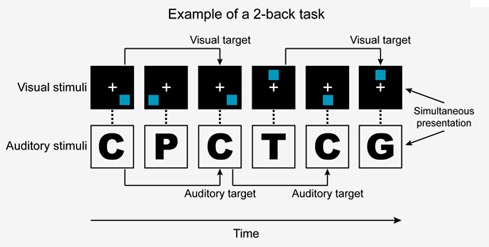
Dual N-Back Training
What is Dual N-back training?
The Dual N-back exercise is a cognitive training exercise that was deigned to stretch and develop working memory capacity (WMC).
The central idea is that you are presented with two simultaneous series to keep track of. Usually these are one series of letters spoken out loud, and another of spatial locations on a 3 by 3 grid. Your task is to identify when either the current letter or current location being presented is identical to one that was already presented a certain number of items ago.

This number is the ‘N’ in N-back. When you start the N-back exercise, you will begin at the 2-back level. Every few seconds one of the 8 squares of the grid lights up (the centre square isn’t used) and at the same time a letter is spoken aloud. This will happen around 20 times and this is one complete set.
If during the set you correctly identify when either a letter or location is presented 2-back at least 80% of the time, the exercise increases N by 1. So you now move on to the 3-back level. If you manage to get 80% right at the 3-back level, N increases by 1 again to 4-back and so on. If you get less than 40% right at any level, N decreases by 1. If you score anywhere between 40% and 80% the next set will be at the same level again.
Does Dual N-back training increase intelligence?
In 2008, Suzanne Jaeggi, a researcher from the University of Michigan, published a paper,’Improving fluid intelligence with training on working memory ‘, which showed participants who had been performing daily 20 minute sessions of the Dual N-Back exercise displayed transferrable, dose-dependant increases in fluid intelligence (Gf).
So not only did their gains transfer over to a wide variety of other tests and measures of intelligence, but the more they trained using the N-back exercise the larger their increases in measures of fluid intelligence.
Jaeggi, and her colleagues followed up this work with a further study published in 2010, ‘The relationship between n-back performance and matrix reasoning — implications for training and transfer’. This not only replicated the results showing Gf and WMC were both enhanced by training with the Dual N-back exercise, but also extended their findings by showing that participants who used the single n-back variation also gained greater increases in Gf and WMC than controls.
A further study by Owen, McMillan, Laird and Bullmore; ‘N-back working memory paradigm: A meta-analysis of normative functional neuroimaging studies ‘, contained a meta-analysis of 24 studies that involved brain scans of participants while performing the N-back exercise. This study showed the significant cognitive demand being placed on participants through the variety of brain regions that were consistently activated by performing this task.
These and many more studies demonstrating both the functional and anatomical changes that are induced by working memory training leave little room for doubt, Dual N-back training can increase intelligence.